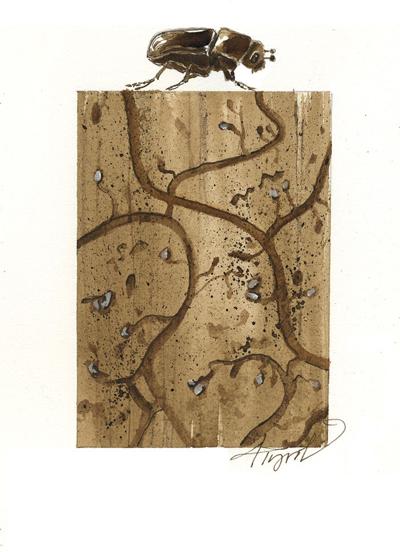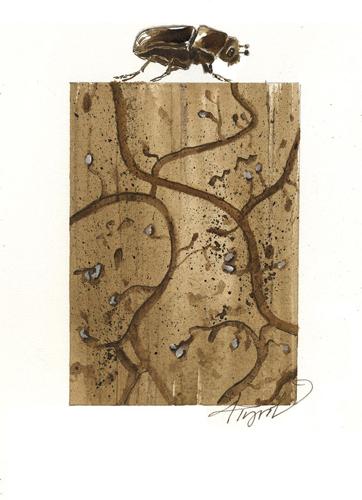By JOE RANKIN
As if the emerald ash borer’s incursion into northern New England wasn’t enough, now there’s another potentially devastating forest pest marching this way: the southern pine beetle.
Dendroctonus frontalis – the first name means “tree murderer,” we should note – is only a fraction of an inch long. But during outbreaks, they reproduce by the millions and can kill trees in a matter of weeks.
“They’re one of the most aggressive tree-killing insects in the world,” said Matthew Ayres, a biology professor at Dartmouth College who has studied the species for 25 years.
A relative of the mountain pine beetle, which periodically ravage the lodgepole- and ponderosa-pine forests of the intermountain West, the southern pine beetle is native to the vast pine forests in the southeastern U.S.
But now, thanks to a warming climate, the beetle is moving north. It’s established itself in New Jersey, Rhode Island, Connecticut, and probably Massachusetts, according to Ayres. In New York, it’s on Long Island and has been trapped near Albany.
“There’s no doubt that northern forests in New Hampshire and Vermont are going to be challenged in the next few years — sooner rather than later — by southern pine beetles,” said Ayres.
Writing in the journal “Nature Climate Change” earlier this year, a team of researchers predicted “a plausible new threat” from the beetle “to vast areas of pine forest in eastern North America by 2050 and into subarctic Canada after 2080 under continued climate change.”
“It is a very big deal” for the northeastern U.S,” said Kevin Dodds, a forest entomologist with the U.S. Forest Service and one of the authors of the article. “It’s definitely a considerable forest pest.”
Cold winters have traditionally limited southern pine beetle’s range. One night at zero degrees Fahrenheit and most beetles are killed, Ayres said. At five degrees below zero, they’re pretty much all dead.
The problem: In the last 50 years in our region, the coldest night of winter has warmed by 7 to 8 degrees, Ayres explained, and in the next 50 years, it could rise another 10 degrees.
Adult female beetles seek out new host trees. When they find a vulnerable pine, they burrow into the bark and release pheromones that alert other beetles, which swarm to the tree.
Scientists call this a “mass attack.” The tree tries to fight back with resin, but the sheer number of invaders overwhelms its defenses. Beetles carve tunnels into the inner bark and lay eggs. After hatching, the larvae tunnel out and fly off to another tree. They can fly up to two miles and can produce multiple generations in a year.
During periodic outbreaks, the beetle’s numbers swell. They spread rapidly and kill pines in vast numbers. They then typically crash. In the south, outbreaks occur roughly on a 6-10 year cycle, though patterns can vary widely.
“The southern pine beetle has been recorded attacking and killing every species of pine with which they come into contact, and that’s more than a dozen,” Ayres said. It favors the “hard” pines like loblolly pine and shortleaf pine. It will kill pitch pines and it’s likely to go after jack pine and red pine, too.
The big unanswered question: How it will treat white pines?
Ayres said the beetle has killed white pines in Alabama, Kentucky, and New Jersey. “We know they’re susceptible. What we don’t know well is how well the beetles reproduce in white pines.”
Kyle Lombard, the forest health program coordinator for the New Hampshire Division of Forests and Lands, said his office is monitoring the bug’s progress. “We are not overly concerned it will be a real threat to our New Hampshire forests,” Lombard said. “We just don’t have a lot of the preferred host, and the winter temps in New England would severely knock it back or completely control it.”
In their mass attacks, southern pine beetles tend to favor forests where the trees grow close together. In New England, white pine doesn’t usually grow in pure stands, but as single trees throughout the woods. That may discourage the beetle.
Unlike with emerald ash borer, where there’s virtually nothing humans can do but wring their hands, thinning uninfected pine stands can help control the southern pine beetle.
“The best management strategy to discourage southern pine beetle outbreaks is to maintain healthy pine stands,” Lombard said.
Ayres agreed but voiced concern for the future. “We can manage it, and we should,” he said. “But we should also take this as a harbinger of other changes and challenges that could be facing northern woodlands. This won’t be the last.”
Joe Rankin lives in Maine. The Outside Story is assigned and edited by Northern Woodlands magazine and sponsored by the Wellborn Ecology Fund of New Hampshire Charitable Foundation.
















(0) comments
Welcome to the discussion.
Log In
Keep it clean. Please avoid obscene, vulgar, lewd, racist or sexual language.
PLEASE TURN OFF YOUR CAPS LOCK.
Don't threaten. Threats of harming another person will not be tolerated.
Be truthful. Don't knowingly lie about anyone or anything.
Be nice. No racism, sexism or any sort of -ism that is degrading to another person.
Be proactive. Use the "Report" link on each comment to let us know of abusive posts.
Share with us. We'd love to hear eyewitness accounts, the history behind an article.